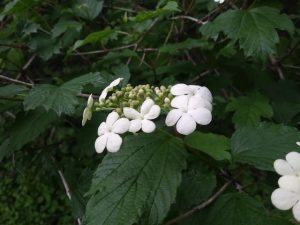maple leaf viburnum
Viburnum acerifolium

Description:
Stems:
Leaves: 3-lobed leaves
Flowers: Flat-topped clusters of white flowers
Fruit/Seeds: Berries turning from red to blue-black.
Locations:
Found in woodlands.
Impact:
Provides good nesting and escape cover for numerous species of birds and small mammals. The fruits of mapleleaf viburnum are eaten by white-tailed deer, rabbits, mice, skunks, ruffed grouse, ring-necked pheasants, wild turkeys, and many species of songbirds. The twigs, bark, and leaves are eaten by white-tailed deer, moose, rabbits, and beavers.
maple leaf viburnum
| USDA Symbol: | Common Name: | Scientific Name: |
|---|---|---|
| VIAC | mapleleaf viburnum | Viburnum acerifolium |
ITIS TSN: 35255
Category: Dicot
Taxonomy
Kingdom: Plantae
Subkingdom:
Super Division: Spermatophyta
Division: Magnoliophyta
Subdivision:
Class: Magnoliopsida
SubClass: Asteridae
Order: Dipsacales
Family: Caprifoliaceae
Counties: Adams, Ashland, Barron, Bayfield, Brown, Calumet, Chippewa, Clark, Crawford, Dane, Dodge, Door, Dunn, Eau Claire, Florence, Fond du Lac, Forest, Iowa, Iron, Jackson, Juneau, Kenosha, Kewaunee, Langlade, Lincoln, Manitowoc, Marathon, Marinette, Menominee, Milwaukee, Monroe, Oconto, Oneida, Outagamie, Ozaukee, Portage, Price, Racine, Richland, Rusk, Sauk, Sawyer, Shawano, Sheboygan, Taylor, Vernon, Vilas, Walworth, Washburn, Washington, Waukesha, Waupaca, Winnebago, Wood
| Duration: | Growth Habit: | Native Status: |
|---|---|---|
| Perennial | Shrub, Subshrub | L48(N)CAN(N) |
| Duration: | Growth Habit: | Native Status: |
|---|---|---|
| Perennial | Shrub, Subshrub |
| NR40 Listed Plant | Noxious Weed: | Invasive Species (NR40): | Threatened/Endangered: | WI Natural Heritage Index: | Wetland Status |
|---|---|---|---|---|---|
| UPL |
Active Growth Period: Spring and Summer
Bloat: None
Carbon to Nitrogen Ratio: Medium
Coppice Potential: Yes
Conspicuous Fall Color: Yes
Fire Resistant: No
Flower Color: White
Conspicuous Flower: Yes
Foliage Color: Green
Foliage Light Porosity Summer: Moderate
Foliage Porosity Winter: Porous
Foliage Texture: Medium
Fruit/Seed Color: Red
Growth Form: Multiple Stem
Growth Rate: Slow
Height at Base Age (Max): 6
Known Alelopath: No
Leaf Retention: No
Lifespan: Long
Re-sproutability: Yes
Shape and Orientation: Erect
Toxicity: None
Height (min):
Height (max):
Root Type:
Leaf Type:
Leaf Arrangement:
Leaf Shape:
Vein Pattern:
Adapted to Coarse Textured Soils: Yes
Adapted to Medium Textured Soils: Yes
Adapted to Fine Textured Soils: No
CaCO3 Tolerance: High
Cold Stratification Required: Yes
Drought Tolerance: High
_Fire Tolerance: Low
Hedge Tolerance: Low
Moisture Use: Medium
pH (Minimum): 4.8
pH (Maximum): 7.5
Planting Density per Acre, Minimum: 2700
Planting Density per Acre, Maximum: 4800
Precipitation (Minimum): 32
Precipitation (Maximum): 50
Root Depth, Minimum (inches): 14
Salinity Tolerance: None
Shade Tolerance: Tolerant
Temperature, Minimum (°F): -28
Plant Spacing (min):
Plant Spacing (max):
| Bloom Period: | Commercial Availability: | Fruit/Seed Abundance: |
|---|---|---|
| Indeterminate | No Known Source | Medium |
| Fruit/Seed Period Begin: | Fruit/Seed Period End: | Fruit/Seed Persistence: |
|---|---|---|
| Summer | Fall | No |
| Propogated by Bare Root: | Propogated by Bulbs: | Propogated by Container: |
|---|---|---|
| Yes | No | Yes |
| Propogated by Corms: | Propogated by Cuttings: | Propogated by Seed: |
|---|---|---|
| No | No | Yes |
| Propogated by Sod: | Propogated by Sprigs: | Propogated by Tubers: |
|---|---|---|
| No | No | No |
| Seeds per Pound: | Seed Spread Rate: | Seedling Vigor: |
|---|---|---|
| 13100 | Slow | Low |
| Small Grain: | Vegetative Spread Rate: | Propagation Treatment: |
|---|---|---|
| No | None |
| Days to Stratify: | Direct Sowing Time: |
|---|---|
Benefits:
| Berry/Nut/Seed Product: | Christmas Tree Product: | Fodder Product: |
|---|---|---|
| No | No | No |
| Fuelwood Product: | Lumber Product: | Naval Store Product: |
|---|---|---|
| -- | No | No |
| Nursery Stock Product: | Palatable Browse Animal: | Palatable Graze Animal: |
|---|---|---|
| No | Medium | Low |
| Palatable Human: | Post Product: | Protein Potential: |
|---|---|---|
| No | No | Low |
| Pulpwood Product: | Veneer Product: |
|---|---|
| No | No |
| Benefits: | Wildlife Food Value: | Wildlife Cover Value: |
|---|---|---|
References:
- Fire Effects Information System (FEIS) – Viburnum acerifolium
- iNaturalist Database – Viburnum acerifolium
- Morton arboretum Database – Viburnum acerifolium
- NRCS Plant Guide – Viburnum aceifolium
- Baird, John W. 1980. The selection and use of fruit by birds in an eastern forest. Wilson Bulletin. 92(1): 63-73
- Gill, John D.; Pogge, Franz L. 1974. Viburnum L. Viburnum. In: Schopmeyer, C. S., ed. Seeds of woody plants in the United States. Agriculture Handbook No. 450. Washington: U. S. Department of Agriculture, Forest Service: 844-850.
Click here for the Native Plants Page
